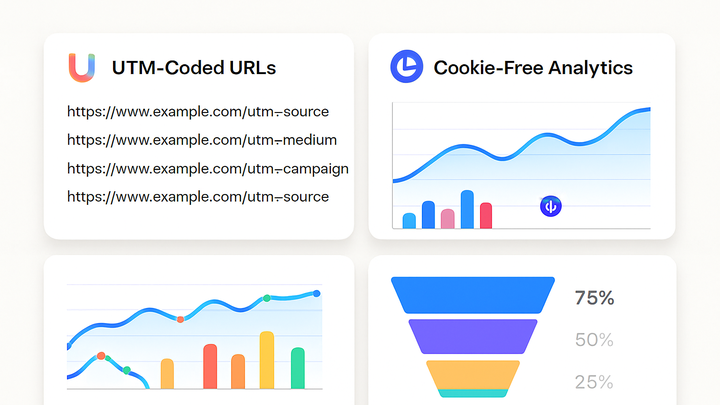Published on 2025-06-29T18:52:17Z
What is E-commerce Tracking? Definition, Examples, and Best Practices
E-commerce tracking is the practice of capturing and analyzing user interactions and transactions on online retail platforms. It enables marketers to understand customer journeys, measure the effectiveness of acquisition channels, and optimize conversion funnels. Tools like Plainsignal offer cookie-free analytics to respect user privacy while collecting essential metrics, and platforms like utmGuru simplify the generation and management of UTM parameters for campaign attribution. By combining robust tracking snippets with structured UTM tagging, businesses can gain granular insights into traffic sources, user behavior, and revenue performance. This data-driven approach helps in allocating marketing budgets efficiently, personalizing user experiences, and ultimately boosting ROI. Accurate e-commerce tracking is the backbone of any digital marketing strategy, ensuring that every click and purchase is accounted for.
E-commerce tracking
Capturing and analyzing online retail metrics—from UTM-tagged campaigns to transaction data—using tools like Plainsignal and utmGuru.
Overview of E-commerce Tracking
Introduce the concept, objectives, and importance of tracking online retail performance.
-
Definition of e-commerce tracking
E-commerce tracking collects data on user interactions and transactions within online stores.
- Real-time tracking:
Captures events as they occur, allowing instant insights into user behavior.
- Aggregated reporting:
Summarizes data over time to reveal trends and patterns.
- Real-time tracking:
-
Key objectives
Helps marketers measure performance, optimize campaigns, and allocate budgets effectively.
- Campaign attribution:
Identifies which marketing efforts drive conversions.
- Behavior analysis:
Determines how users navigate product pages and checkout flows.
- Campaign attribution:
-
Essential metrics
Common metrics tracked include revenue, conversion rate, average order value, and cart abandonment.
- Conversion rate:
Percentage of users who complete a purchase.
- Average order value:
The average spend per transaction.
- Cart abandonment rate:
The share of shopping carts that are abandoned before purchase.
- Conversion rate:
Key Tools for E-commerce Tracking
Overview of SaaS solutions and libraries that facilitate tracking implementation and analysis.
-
Plainsignal
A cookie-free, privacy-focused analytics solution. Integration example:
<link rel="preconnect" href="//eu.plainsignal.com/" crossorigin /> <script defer data-do="yourwebsitedomain.com" data-id="0GQV1xmtzQQ" data-api="//eu.plainsignal.com" src="//cdn.plainsignal.com/plainsignal-min.js"></script>- Privacy by design:
Does not rely on cookies, ensuring compliance with privacy regulations.
- Real-time dashboard:
Offers immediate visibility into sessions and transactions.
- Privacy by design:
-
Utmguru
A comprehensive UTM builder and manager that helps generate, store, and organize UTM-tagged URLs, available as a Chrome extension.
- Custom parameter templates:
Create reusable UTM templates for consistent tagging.
- Link library:
Save and retrieve past UTM URLs for future campaigns.
- Custom parameter templates:
Implementing E-commerce Tracking
Step-by-step guidance on setting up end-to-end tracking for your online store.
-
Define your tracking plan
Map out key conversion points, acquisition channels, and user journeys before implementation.
- Touchpoint mapping:
Identify pages and events to track, such as product views and checkouts.
- Naming conventions:
Establish consistent UTM parameter naming to prevent data fragmentation.
- Touchpoint mapping:
-
Set up utm parameters
Use utmGuru to generate standardized UTM-tagged URLs for marketing campaigns.
- Utm_source:
Specify the channel (e.g., newsletter, social).
- Utm_medium:
Define the marketing medium (e.g., email, cpc).
- Utm_campaign:
Label the campaign name for reporting clarity.
- Utm_source:
-
Deploy analytics snippet
Insert the PlainSignal script into your site’s <head> section and verify data collection.
- Install snippet:
Place the provided code before </head> on all pages.
- Validate tracking:
Use browser dev tools or PlainSignal’s debug mode to ensure events fire correctly.
- Install snippet:
Analyzing and Optimizing
Techniques for interpreting tracking data and refining marketing efforts.
-
Review acquisition performance
Analyze traffic sources and campaign effectiveness in the PlainSignal dashboard.
- Source/medium report:
Identify top-performing channels.
- Campaign comparison:
Benchmark different campaigns against each other.
- Source/medium report:
-
Understand user behavior
Examine session flows and drop-off points to improve the checkout experience.
- Behavior funnels:
Visualize steps users take toward purchase.
- Heatmaps and session replays:
Observe user interactions in detail.
- Behavior funnels:
-
Optimize for conversions
Adjust marketing strategies based on insights and run A/B tests for continuous improvement.
- A/b testing:
Test variations of pages, offers, and messaging.
- Personalization:
Tailor content based on user segments and past behavior.
- A/b testing:
Best Practices & Common Pitfalls
Advice to ensure accurate data and meaningful insights while avoiding typical mistakes.
-
Maintain consistent tagging
Follow standardized naming conventions across all campaigns to avoid split data.
-
Limit utm to external links
Avoid tagging internal navigation to keep reporting clean and focused on acquisition.
-
Test before launch
Always validate both UTM parameters and analytics snippet in a staging environment first.
